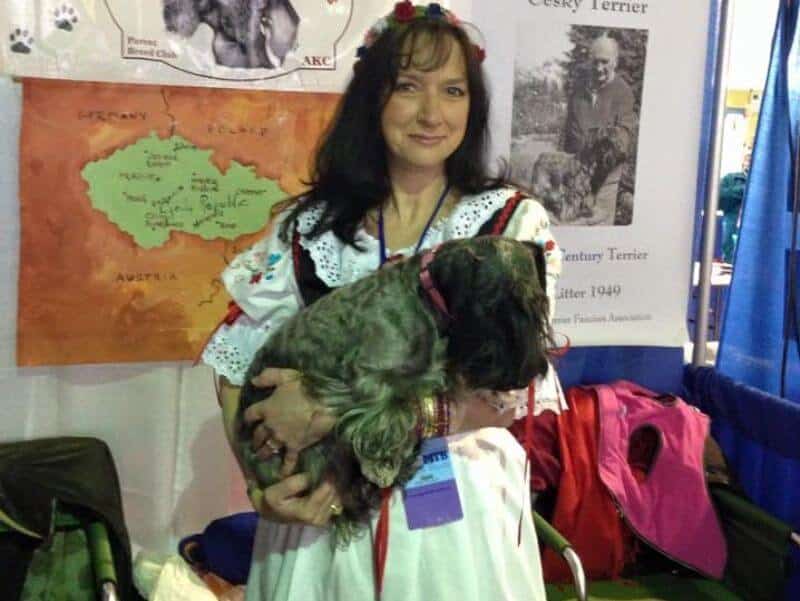Interview with Julie Gritten, Breeder of Julerr Cesky Terriers
Please tell us a little bit about yourself. Where do you live? What is your breed? What is your kennel name? Do you have a website? How long have you been in dogs? How long have you been breeding dogs? Who are some of your best-known dogs?
Julie Gritten: I am a breeder/owner-handler of Cesky Terriers, located in Paradise Valley, Montana, and I breed under the prefix “Julerr.” We do not have a website, but with our active involvement in Conformation, working terriers, and Performance activities, our dogs are shining stars representing the breed and its versatility. I have been breeding dogs for over 60 years, starting with our family’s working Border Collies in the Midwest, involvement in later years with Scottish Terriers, and now for the past 10 years with the Cesky Terrier.
Many of my Ceskys are working dogs and Performance-titled dogs. We are dedicated to the preservation of the Cesky and purpose-bred dogs that can do the job they were originally bred to do. Our best-known dogs include: GCH Julerr Anisette Alegretto FDC RATN DCAT TL-1 UL-1 TL-lX UL-lX TN-1, National BISS 2022, Best BBE, Best Brood Bitch; GCHB Julerr Akvavit Avante FDC AX AXJ MJP OF CA FCAT3 RATO CGC TKN ATT, National BISS 2021; GCH Julerr First Class All The Way FDC AX MXJ OF FCAT SBN RATM CZ8B CGC, National Specialty BOS 2021; CAN GCH Julerr For The Rebel Alliance CD RA NS SN TKA ADC SGDC SDA CRA CRAT TL-1 SD-1, National Specialty BOW 2022; GCH Julerr Dream A Little Dream, BBE Best in Show, AKC National Championship BOB, BP, BBE, and Best Owner-Handled 2018; and Julerr Hanging On A Star UL-1 SD-1 LI-1 UL-ll LI-ll.
As a Breeder, can you share your thoughts on your breed today? Is breed type strong? Are there things to be concerned about? Are there any health-related issues? Have you worked with breeders overseas? Are pet homes typically available for your breed?
Julie Gritten: Our breed is floundering in type at present. Breed type is all over the board, making it very difficult for some to understand the breed and its Standard. I work very closely with the original breedings in the Czech Republic to ensure that I am knowledgeable enough to continue to breed according to the vision of the creator of the Cesky Terrier, Mr. Frantisek Horak, preserving type according to the people’s National Breed and to preserve the working ability along with correct structural components that make this breed what it was intended to be.
The Cesky Terrier is a wonderful companion for families, when correctly bred. It has the capability to hunt in the field all day and return home to be a loyal and devoted companion, making it a truly versatile breed.
As an Exhibitor, can you comment on recent entries in your breed? Are majors available in your area? Does your breed often participate in Companion and Performance events? How can newcomers in your breed be encouraged to join the sport of dogs?
Julie Gritten: Entries in the breed fall between a handful in the Western US and absolutely no majors in my area, so long distance traveling to earn points is required for myself and my dogs. I do not believe in padding the ring with all of my own dogs to garner championships. In Conformation, I want to show judges the best examples I am able to present to them. It means more to me to help judges and future breeders understand what this breed truly is and how correct structure helps the Cesky Terrier do its job.
What are the biggest challenges facing the dog show community as a whole and how can we address them? And finally, what are some of the positive changes you’ve seen in your breed and in the dog show community as a whole over the past decade?
Julie Gritten: One of the positive changes I have seen in the dog show community is the desire to present dogs that can and do perform the jobs they were meant to do, whether it is to hunt vermin, such as the Cesky, or a Border Collie to prove its original purpose of herding by participating in activities that test those characteristics and structure to be able to perform those tasks.








